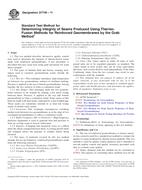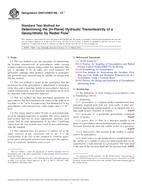Potřebujeme váš souhlas k využití jednotlivých dat, aby se vám mimo jiné mohly ukazovat informace týkající se vašich zájmů. Souhlas udělíte kliknutím na tlačítko „OK“.
ASTM D7749-11
Standard Test Method for Determining Integrity of Seams Produced Using Thermo-Fusion Methods for Reinforced Geomembranes by the Grab Method
Automaticky přeložený název:
Standardní zkušební metoda pro stanovení integrity švy vyrábějí za použití metod Thermo-Fusion posílené geomembranes strany Grab metody
NORMA vydána dne 1.10.2011
Informace o normě:
Označení normy: ASTM D7749-11
Poznámka: NEPLATNÁ
Datum vydání normy: 1.10.2011
Kód zboží: NS-39059
Počet stran: 6
Přibližná hmotnost: 18 g (0.04 liber)
Země: Americká technická norma
Kategorie: Technické normy ASTM
Kategorie - podobné normy:
Anotace textu normy ASTM D7749-11 :
Keywords:
ICS Number Code 59.080.70 (Geotextiles)
Doplňující informace
| Significance and Use | ||||||||
|
The use of reinforced geomembranes as barrier materials has created a need for a standard test method to evaluate the quality of seams produced by thermo-fusion methods. This test method is used for quality control purposes and is intended to provide quality control and quality assurance personnel with data to evaluate seam quality. Values obtained with this method can be correlated to . The purpose of correlating these methods was for the strength of parent material measured in to be comparable to seam strength measured by the test outlined here. The value obtained with this method cannot be compared to values for strip method for parent material or ASTM DXXXX strip method for reinforced seams. |
||||||||
| 1. Scope | ||||||||
|
1.1 This test method describes destructive quality control tests used to determine the integrity of thermo-fusion seams made with reinforced geomembranes. A test procedure is described that uses seam tests using grab specimens for seam shear strength. 1.2 The types of thermal field and factory seaming techniques used to construct geomembrane seams include the following. 1.2.1 Hot Air—This technique introduces high-temperature air between two geomembrane surfaces to facilitate melting. Pressure is applied to the top or bottom geomembrane, forcing together the two surfaces to form a continuous bond. 1.2.2 Hot Wedge—This technique melts the two geomembrane surfaces to be seamed by running a hot metal wedge between them. Pressure is applied to the top and bottom geomembrane to form a continuous bond. Some seams of this kind are made with dual tracks separated by a non-bonded gap. These seams are sometimes referred to as dual hot wedge seams or double-track seams. 1.2.3 Extrusion—This technique encompasses extruding molten resin between two geomembranes or at the edge of two overlapped geomembranes to effect a continuous bond. 1.2.4 Radio Frequency (RF) or Dielectric—High frequency dielectric equipment is used to generate heat and pressure to form an overlap seam in factory fabrication. 1.2.5 Impulse—Clamping bars heated by wires or a ribbon melts the sheets clamped between them. A cooling period while still clamped allows the polymer to solidify before being released. 1.3 The types of materials covered by this test method include, but are not limited to, reinforced geomembranes made from the following polymers. 1.3.1 Very Low Density Polyethylene (VLDPE). 1.3.2 Linear Low Density Polyethylene (LLDPE). 1.3.3 Flexible Polypropylene (fPP). 1.3.4 Polyvinyl Chloride (PVC). 1.3.5 Chlorosulfonated polyethylene (CSPE). 1.3.6 Ethylene Interpolymer Alloy (EIA). 1.4 Units—The values stated in either SI units or inch-pound units are to be regarded separately as standard. The values stated in each system may not be exact equivalents; therefore, each system shall be used independently of the other. Combining values from the two systems may result in non-conformance with the standard. 1.5 This standard does not purport to address all of the safety concerns, if any, associated with its use. It is the responsibility of the user of this standard to establish appropriate safety and health practices and determine the applicability of regulatory limitations prior to use. |
||||||||
| 2. Referenced Documents | ||||||||
|
Podobné normy:
Historická
1.7.2010
Historická
1.7.2013
Historická
1.10.2011
Historická
1.3.2010
Historická
1.1.2013
Historická
1.6.2011
Doporučujeme:
Aktualizace technických norem
Chcete mít jistotu, že používáte pouze platné technické normy?
Nabízíme Vám řešení, které Vám zajistí měsíční přehled o aktuálnosti norem, které používáte.
Chcete vědět více informací? Podívejte se na tuto stránku.



 ASTM D6497-02(2010)..
ASTM D6497-02(2010).. ASTM D6574/D6574M-13..
ASTM D6574/D6574M-13.. ASTM D6637-11
ASTM D6637-11 ASTM D6693-04(2010)..
ASTM D6693-04(2010).. ASTM D6706-01(2013)..
ASTM D6706-01(2013).. ASTM D6707-06(2011)..
ASTM D6707-06(2011)..
 Cookies
Cookies
